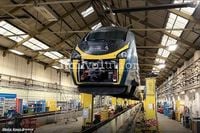Passengers traveling on some of the busiest rail routes in the United Kingdom are set for a significant upgrade, as two major developments promise to transform comfort, capacity, and reliability on the rails. Chiltern Railways has unveiled its new Mark 5A trains, poised to add over 10,000 seats each weekday from early 2026, while Knorr-Bremse Rail Services (UK) has secured a long-term contract to overhaul the sanitary systems on the Class 390 trains that form the backbone of the West Coast Main Line. Together, these initiatives reflect a broader push to modernize Britain’s railway infrastructure and enhance the travel experience for millions.
Chiltern Railways, a key operator connecting London with the West Midlands, Aylesbury, and Oxford, showcased its latest fleet at London Marylebone station earlier this week. The new 13-train fleet, featuring the Mark 5A carriages, will replace some of the oldest rolling stock on the network—carriages that have been in service for up to half a century. The upgrade is not just cosmetic; it’s a leap forward in capacity and amenities. According to Chiltern Railways, the introduction of these trains will enable the company to deliver more than 10,000 extra seats for customers every weekday starting in early 2026, a move expected to alleviate crowding and improve the overall journey for commuters and leisure travelers alike.
Richard Allan, Managing Director of Chiltern Railways, expressed his excitement at the unveiling. “We are thrilled for customers that we are replacing our oldest coaches with much newer trains, and as a result we plan to provide 10,000 more seats on our network every weekday from the end of 2026,” Allan stated, as reported by Railway-News. He added, “The unveiling of the first of our newest trains at London Marylebone is a positive, tangible sign of better times ahead for customers. There are better on-board facilities and more services planned from the end of 2026, subject to the usual rail industry approval processes.”
The new trains are packed with features designed for modern travelers. Each vehicle will offer enhanced Wi-Fi, plug sockets, and USB ports at every seat, ensuring that passengers can stay connected and productive on the go. Digital customer information screens will provide real-time updates, while air conditioning and increased luggage space aim to make journeys more comfortable. Accessibility has also been prioritized, with the trains boasting dedicated spaces with fully accessible toilets and improved boarding and seating arrangements for passengers with reduced mobility.
The government’s role in supporting this modernization was underscored during the launch event, when Rail Minister Lord Hendy toured the first new train alongside Allan. Hendy described the investment as a testament to the government’s commitment to building a rail industry fit for Britain’s future. “These trains will give a fresh look and greater capacity for Chiltern’s passengers, giving better journeys while using cleaner fuel, and this investment reflects the Government’s unwavering commitment to building a rail industry that Britain needs and deserves as part of its Plan for Change,” he said, according to Railway-News. Hendy confirmed that, thanks to government support, the new trains will start entering service from early next year, with a phased rollout continuing through 2026.
But the upgrades don’t stop with new rolling stock. Chiltern Railways is also collaborating with Network Rail and the Department for Transport to explore replacing its 35-year-old diesel trains with battery-electric models. “We are making good progress with our vision and plan to modernise and decarbonise Chiltern; the next stage is to continue working with Network Rail and the Department of Transport on the business case to replace our 35-year old diesel trains with battery-electric trains,” Allan noted. This signals a long-term commitment not only to passenger comfort but also to environmental sustainability.
While Chiltern Railways focuses on new trains and greener technology, another critical aspect of passenger experience—sanitation—is getting a major overhaul elsewhere on the network. On October 17, 2025, Knorr-Bremse Rail Services (UK) announced it had won an eight-year contract from Alstom to repair and overhaul 510 sanitary systems fitted to the Class 390 trains. These trains, built by Alstom, serve as the backbone of the UK’s West Coast Main Line, one of the nation’s busiest and most important rail corridors.
The sanitary systems in question were originally supplied by Evac, a company acquired by Knorr-Bremse in June 2021. This acquisition brought Evac’s advanced product range under the Knorr-Bremse umbrella, further strengthening the company’s position as a global leader in rail sanitary technology. With over 200,000 sanitary systems delivered worldwide, Knorr-Bremse’s expertise is well established, and the new contract with Alstom is seen as a vote of confidence in the quality and reliability of its technology and aftermarket services.
The overhaul program will be carried out at Knorr-Bremse’s dedicated facility in Wiltshire, with each unit being stripped down after removal from Alstom’s Manchester Traincare Centre in Longsight. Key components—including vacuum pumps, sliding gate valves, and solenoid valves—will be inspected, refurbished, or replaced as necessary. After rigorous testing, each sanitary unit will be returned to Longsight for reinstallation on the Class 390 trains.
According to Railway-News, the upgraded sanitary systems will leverage advanced vacuum technology to provide passengers with hygienic, water-efficient wastewater disposal. The improvements are expected to boost both the reliability and comfort of the Class 390 fleet, ensuring that travelers on the West Coast Main Line benefit from cleaner, more dependable facilities—no small matter for those making long-distance or regular journeys.
Knorr-Bremse highlighted that this long-term agreement not only underscores the proven quality of its sanitary solutions but also reflects Alstom’s confidence in its ability to deliver specialized aftermarket services. With the overhaul program set to run for eight years, passengers can expect a sustained focus on maintaining high standards of cleanliness and functionality aboard one of the UK’s most vital train fleets.
Taken together, these developments paint a picture of a rail industry in transition—one that is embracing new technology, prioritizing passenger needs, and aiming for a more sustainable future. Whether it’s the promise of more seats and better amenities on Chiltern Railways or the assurance of cleaner, more reliable facilities on the West Coast Main Line, the message is clear: Britain’s railways are on track for a new era of comfort and efficiency. For the millions who depend on these services every day, that can only be welcome news.




